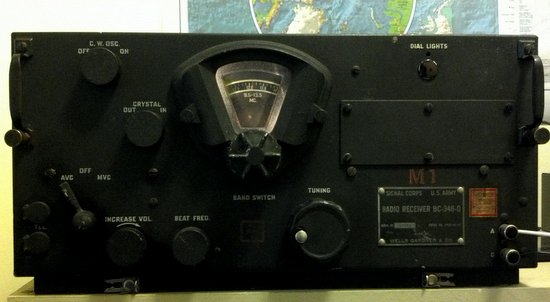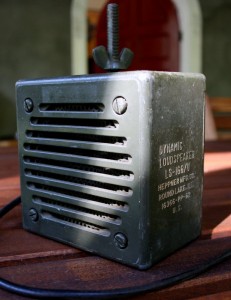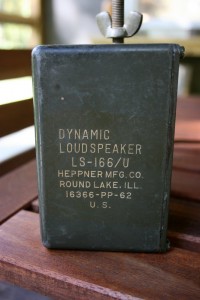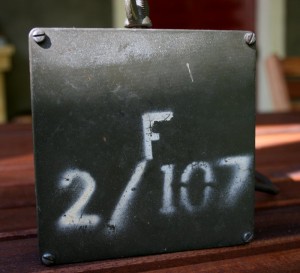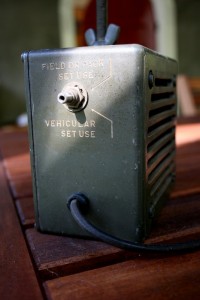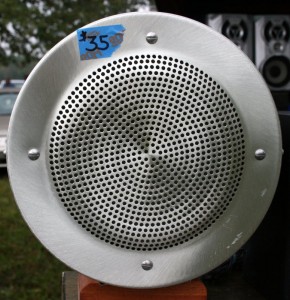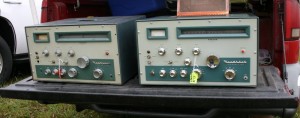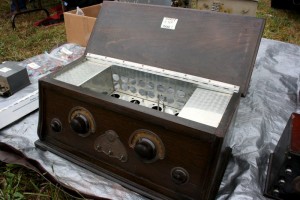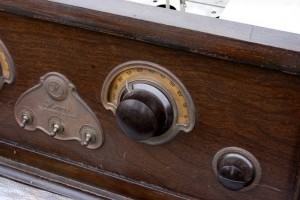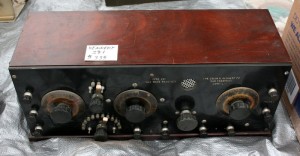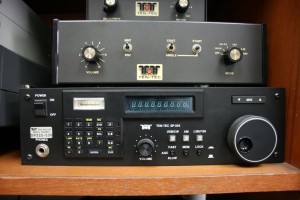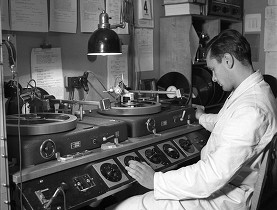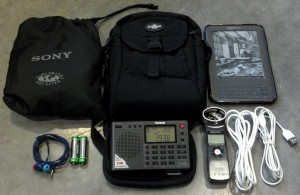
Though I only travel with one carry on bag, it doesn’t mean I can’t accommodates my shortwave radio/recording pack.
Having just returned from nearly three full weeks of traveling, I’m more convinced than ever that my just-one carry-on bag approach makes absolute sense. In one bag, I’m able to take everything I need, including casual and business attire, toiletries, first aid and, yes, of course, my portable shortwave radio (never leave home without it!) and my Zoom H1 recorder.
One bag freedom
Years ago, while working for a fiber optics company in Europe, I learned the trick to keeping my cool during frequent air travel was simply to avoid, at all costs, checking in baggage. Over the course of several years, I honed the contents of my travel bag down to the bare essentials, and even for longer trips in developed countries, made the (correct) assumption that any supplies I required could be found at my destination.
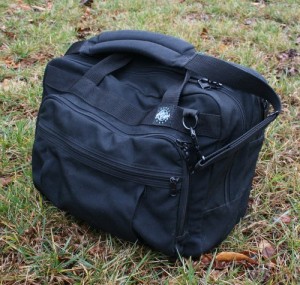
My circa 1999 Eagle Creek convertible laptop bag has traveled thousands of miles. It’s just big enough to accommodate everything I need for several days or even weeks travelling.
For twelve years now, I have been using one of three Eagle Creek carry-on convertible bags. Two of these plain black bags look much like the ubiquitous vertical rolling luggage you see every day in major airports, but they hide two secrets: each can be converted into a full-fledged backpack, and each meets the most stringent standards for carry-on luggage. They’re also built to take a beating, which they’re getting, and have a lifetime warranty.
The third Eagle Creek pack is basically a roomy laptop (and radio) bag (see photo on left). It has no wheels, and can be worn with a shoulder strap…or, again, converted into a simple two-strap backpack.
When traveling alone, I can easily get by with only the third and smallest of my Eagle Creek pack: the laptop bag. It has a very roomy, padded compartment for my laptop, a middle compartment where I fit my bundled clothes, first aid, and radio pack (which also holds my Kindle), and a front section with organizers for office supplies and a convenient place to stash my travel docs and passport. It’s also a very simple to make this pack virtually pickpocket-proof.
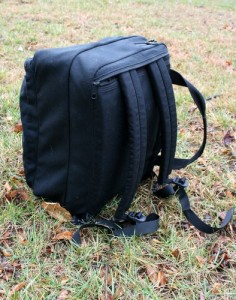
This laptop bag quickly converts into a backpack–a useful feature when it’s fully loaded and you need both arms free.
Check-in-proof!
The benefit of using this particular Eagle Creek laptop bag (important: the one without wheels) is that–even if I’m being loaded in the last zone of a flight, even if the flight is fully booked, and even if the flight is on a De Havilland Dash 8-100–I always find a place for my bag on board, and never, ever, have to gate-check my bag. It will fit in a small overhead compartment, or at the very least, under the seat in front of me.
Though the compromise is that I travel light, the great benefit is that I never have lost any bags, rarely miss a connecting flight (it typically takes at least five extra minutes to claim even a gate-checked bag), and I zoom in an out of an airport. I have the luxury of sitting back and reading while I watch others panic at a gate, waiting for their appropriate “zone” to load.
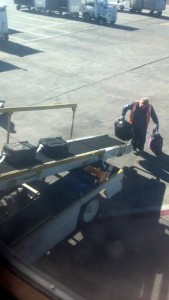
From my seat, I watched US Air load wheeled carry-on luggage that they required some unfortunate passengers (who were already on the plane!) to check in.
Over the past decade, air travel has really changed. Most of the domestic flights I took throughout Europe a decade ago used to be only about two-thirds full. Here in the US, it appeared to be roughly the same. Today, however, airlines have cut back their offerings and frequently overbook flights. In fact, on a recent flight returning from Denver International Airport, the airline warned of penalty charges if passengers attempted to carry on more luggage or weight than allowed. The airline was making anyone with a wheeled bag–no matter how small–check it in.
Since I was in the eighth row seat, and I only had my Eagle Creek laptop bag on a shoulder strap, I waited until almost everyone else had boarded before I got in line. I walked straight into the 737, pulled my radio pack out of my laptop bag, stowed the laptop bag in the overhead compartment, and settled into my seat. No sweat. Meanwhile flight attendants were taking extra baggage from travelers in the back of the plane and checking in their luggage on the spot. Though their bags met overhead compartment criteria, there simply wasn’t enough room.
Confession time: So, I am something of a pack addict…!
My wife recently pointed out that, besides radios, I have too many packs. I’m convinced I do this because I’m always searching for the best, most versatile way to travel. Most of the packs I buy these days are smaller ones to compliment my Eagle Creek packs. I’m a choosy pack connoisseur, too: I often save my dollars and seek something made in the US–or in Europe, Australia or South Africa (true of pack-maker Karrimore, at one point). I don’t typically like the mass-produced stuff, which I find is not as well-made. My original three Eagle Creek packs were made in the USA, but after the company was featured on the American TV talk show Oprah, receiving the host’s endorsement, the unfortunate result is that the company’s products have since (in my opinion) been compromised and manufacturing moved overseas, likely to keep up with new demand.
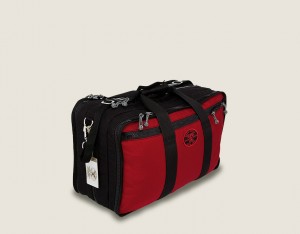
Red Oxx actually designed their Air Boss bag for one-bag travelers like me. It even meets the strictest international carry-on standards.
Since a good friend just sang US company RedOxx’s praises, I’m currently drooling over the RedOxx’s Air Boss and SkyTrain. Both look like they would do the trick, but make me slightly nervous because they are a couple of inches larger than my trusty-if-“rusty” Eagle Creek laptop bag, in two dimensions. If RedOxx’s uber-affordable Extra Small Aviator Bag had a shoulder strap and could accommodate a small laptop, I would even consider trying that bag–perhaps in combo with their Gator Carry-On Bag, this would make sense (but that would make for two bags, not sure about that).
I suppose I could also consider the US company Tom Bihn Tri-Star, though it is probably more bag than I really need.
Note that although these bags are pricey, all come with a no-hassle, no-questions-asked, lifetime warranty–the Redd Oxx warranty, in particular, is worth a read–both companies are also noted for excellent customer service and the bags should last my lifetime.
Unless, that is, I find another that I want to test drive. Filled with of radio gear, of course. Ah, well…My wife appears to be right.
Have radio, will travel
I suppose the reason I’m entertaining this slightly off-topic travel subject is not just due to my recent travel, but because I’m now enlightened enough to realize that traveling light never means traveling without a radio. With some careful planning and packing, choosing the right bag–and travel-companion radio–the whole world is waiting for you. And you won’t find yourself spending your travel time–and radio listening time!–watching bulky suitcases drift round on the conveyor belt at baggage claim, as you wait for yours.
Anyone else out there have a similar bag addiction? Got one you like? Radio travelers, share your thoughts!
If you are into one-bag travel, you should check out the following excellent sites (thanks for the links, Ed):

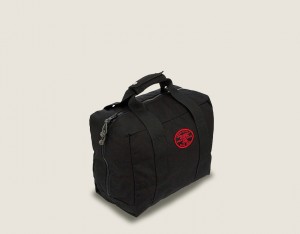
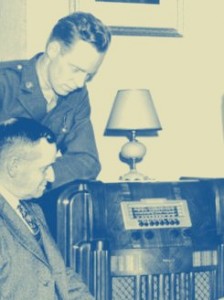 I’ve always believed that, over time, the process of listening through static to hear a distant shortwave broadcast, has been good for not only increasing my listening skills in general, but has been healthy for the grey matter. Seth S. Horowitz, auditory neuroscientist at Brown University, has just substantiated this belief in his NY Times piece,
I’ve always believed that, over time, the process of listening through static to hear a distant shortwave broadcast, has been good for not only increasing my listening skills in general, but has been healthy for the grey matter. Seth S. Horowitz, auditory neuroscientist at Brown University, has just substantiated this belief in his NY Times piece, 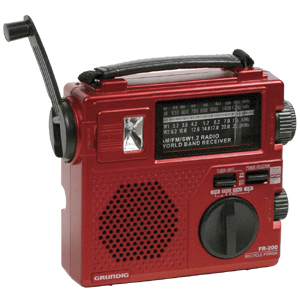
 (Source:
(Source: 